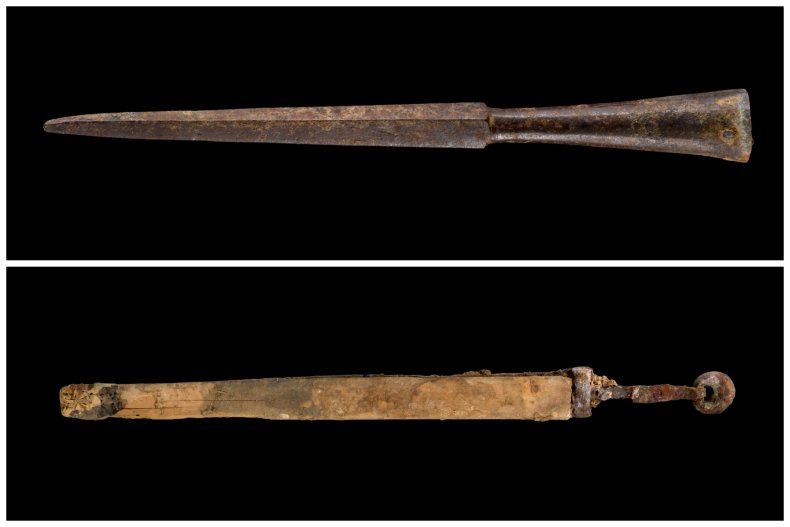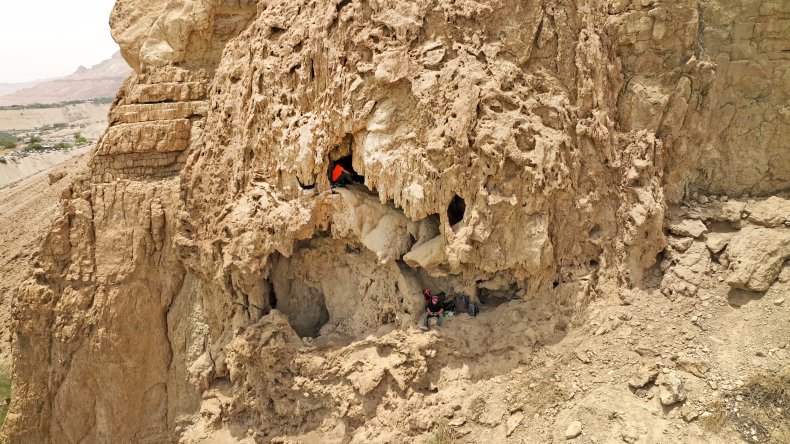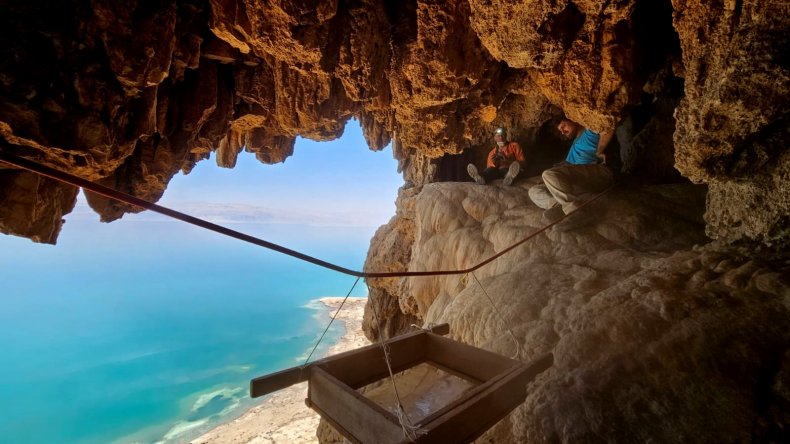A rare cache of ancient weapons from the Roman period has been discovered stashed away in a remote cave in Israel.
The cache includes four exceptionally well-preserved Roman swords from 1,900 years ago, the Israel Antiquities Authority (IAA) announced on Wednesday. It also contained a shafted weapon known as a pilum—a type of javelin generally measuring around 6 feet in length that was used by the Roman army in ancient times.
“Finding a single sword is rare—so four? It’s a dream! We rubbed our eyes to believe it,” IAA researchers said in a press release.

Dafna Gazit / Israel Antiquities Authority
The cave in which archaeologists found the weapons is located in the En Gedi Nature Reserve, which covers an area just to the west of the Dead Sea. The cave is small and nestled within a set of isolated and inaccessible cliffs, the antiquities authority said.
The En Gedi reserve forms part of the Judean Desert, which lies east of Jerusalem and descends to the Dead Sea. The desert is spread out across parts of the West Bank and Israel.
Researchers said the weapons may have been hidden in the cave by Jewish rebels who rose up against Roman rule. It is possible the rebels seized the weapons from the Roman army as booty.
“This is a dramatic and exciting discovery, touching on a specific moment in time,” IAA Director Eli Escusido said in the press release. “Not all are aware that the dry climatic conditions pertaining in the Judean Desert enable the preservation of artifacts that do not survive in other parts of the country. This is a unique time capsule.”
The weapons were discovered when two researchers and an IAA photographer visited the cave to study a stalactite featuring an ancient Hebrew inscription that was found 50 years ago.
During this visit, one of the experts, Asaf Gayer with the Department of Land of Israel Studies and Archaeology at Ariel University, spotted the pilum in a deep, narrow crevice on the cave’s upper level.




Emil Aladjem / Israel Antiquities Authority
Gayer and his colleague, geologist Boaz Langford of the Institute of Earth Sciences and the Cave Research Center at Jerusalem’s Hebrew University, subsequently reported the discovery to the IAA.
The authority is conducting a systematic scientific project in the caves of the Judean Desert. As part of this initiative, known as the Judean Desert Survey Project, archaeologists have investigated hundreds of caves in the region over the past six years. In addition, experts have carried out 24 excavations at selected caves with the aim of saving archaeological remains from being looted.
Gayer, Langford and the survey team returned to the cave to carry out further investigations of all of the crevices in the cave. During these investigations, they found the four Roman swords in an almost inaccessible crevice on the upper level.
The swords are exceptionally well preserved, the researchers said. With three of them, the iron blade was found inside a wooden scabbard, with the blades as “sharp as if they had only just been hidden away today,” Escusido said.
The swords have well-fashioned hands made of wood or metal. Three have blades measuring around 24 to 26 inches in length, with researchers identifying them as Roman spatha swords. The remaining sword was somewhat shorter, with a blade measuring around 18 inches in length, according to the researchers.
“The hiding of the swords and the pilum in deep cracks in the isolated cave north of En Gedi hints that the weapons were taken as booty from Roman soldiers or from the battlefield, and purposely hidden by the Judean rebels for reuse,” Eitan Klein, one of the directors of the Judean Desert Survey Project, said in the press release.
“Obviously, the rebels did not want to be caught by the Roman authorities carrying these weapons,” Klein said.
After finding the artifacts, the team carefully removed them from the crevice and transferred them to the IAA’s climate-controlled laboratories for preservation and conservation. An initial examination of the objects found that these were standard swords used by Roman soldiers stationed in the ancient territory of Judea.
Following the discovery of the swords, archaeologists conducted a thorough excavation at the cave, unearthing other artifacts dated to around 6,000 years ago, as well as the Roman period around 2,000 years ago.
At the entrance to the cave, archaeologists found a bronze coin from the time of the Bar Kokhba Revolt—a rebellion of Jews against Roman rule in Judea—of A.D. 132 to 135.




Oriya Amichai / Israel Antiquities Authority
Researchers said the recent findings at the cave shed new light on how the Jewish population exploited the caves of the Judean Desert.
“We are once again presented with thrilling findings from the Judean Desert that offer a glimpse into the daily lives of our ancestors who resided in this area about 2,000 years ago,” Rabbi Amichai Eliyahu, the Israeli Minister of Heritage, said in a statement.
Further studies of the cave and the weapons that have been found in it are being carried out to yield more information.
“We are just beginning the research on the cave and the weapon cache discovered in it, aiming to try to find out who owned the swords, and where, when and by whom they were manufactured,” Klein said. “We will try to pinpoint the historical event that led to the caching of these weapons in the cave and determine whether it was at the time of the Bar Kokhba Revolt.”
This post was originally published on this site be sure to check out more of their content.








